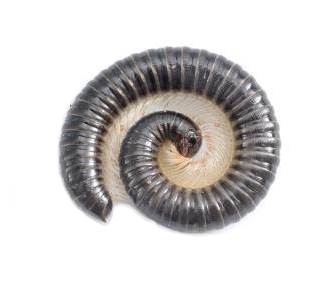 Centipedes and millipedes are very similar as far as their appearance goes. Both are known for their multiple legs, with centipedes referred to as “hundred leggers” and millipedes as “thousand leggers.” Millipedes’ legs are also shorter and, in general, cannot move very fast. A centipede, with its fewer legs, can travel considerably faster. They each are found throughout all areas of the United States.
Centipedes and millipedes are very similar as far as their appearance goes. Both are known for their multiple legs, with centipedes referred to as “hundred leggers” and millipedes as “thousand leggers.” Millipedes’ legs are also shorter and, in general, cannot move very fast. A centipede, with its fewer legs, can travel considerably faster. They each are found throughout all areas of the United States.
Biology & Reproduction
Centipedes:
Centipede coloring can range from a yellowish to dark brown, sometimes with dark stripes or other markings. They’re an overwintering pest, and will typically stay outdoors when overwintering in protected environments. All of them have poison jaws that they use to inject venom into their prey to kill them. If they’re handled roughly, centipedes, especially the larger species, can bite and break human skin. Their bite isn’t lethal. It’s similar to a bee sting, with the bite causing some pain and swelling. Centipedes begin to reproduce in the summer, and lay 35 eggs over several days and lay them in or on the soil.
Millipedes:
Millipedes’ color can vary depending on the species and can be black, brown, red, orange or with molted patterns. They overwinter, and begin reproduction in the summer. They’ll lay 20-300 eggs within soil or decaying matter. After a few weeks the eggs will hatch and can live for several years. Millipedes don’t bite but will give off a repulsive smelling fluid from their body. This fluid can be toxic to small animals and can cause small blisters on humans.
Habits
Centipedes:
Most centipedes are found in high moisture areas like loose bark, rotten logs, underneath stones, trash, leaf and grass clipping piles, mulch, and more depending on where they find prey. They’re also typically most active at night. They’ll survive off of spiders and flies in their adult stage, or even plants. When they invade a home you can find them in basements, closets, and potted plants, wherever there are areas inside with high amounts of moisture.
Millipedes:
Millipedes, like Centipedes, also must live in high moisture areas and are nocturnal. They don’t survive indoors for more than a few days unless there is moisture and available food sources. Millipedes are scavengers and will feed on decaying plants and occasionally on dead insects, earthworms, and snails. Sometimes they’ll eat live plants to gain more moisture, and can be a serious issue if they infest a greenhouse.
Control
Centipedes are beneficial because they eat other nuisance pests, which is a good reason to keep them around if they aren’t a serious bother to you. Reducing moisture is important for downsizing population. Mowing your lawn and removing loose, unnecessary debris like leaves and rocks can be helpful. Proper treatment by a professional may be necessary.

